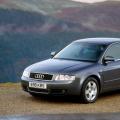The US auto industry is the largest in the world, but we are afraid to buy its products! New overseas cars are in showrooms for months, and buying a second-hand "American" is comparable to suicide. Unraveling the detective story, what is the reason for mistrust.
It's strange, but true: we don't like american cars... Moreover, cars of Japanese and European brands from America, even if they were once imported into the United States, are valued much lower than those sold in our country or in Europe. And if a brand or model was sold only in the States, then the attitude is very specific, and only a few fans of the brand or model appreciate it.
It's a little strange to see if you know that the same, deeply loved by the people, BMW X5-X6 are produced at the Spartanburg plant in the USA. The same story - with Mercedes M-Class and a number of other models that we used to consider European.
And nothing after all! These "Americans" are driving, they are not particularly annoying with problems, and most owners are not even aware of the origin of their cars. So it's all about stereotypes? And in general, where does this wary attitude come from, what gave rise to it and would not it be time to forget about it? Let's try to figure it out.
The classics still die
Why lovers of the classic American car industry stand apart from ordinary motorists, in general, it is not a secret. Multi-liter engines that need to be fed with large volumes of gasoline, pivot suspensions, large interiors of huge cars - all these features of the classic American car industry are slowly becoming a thing of the past, leaving an indelible mark on the hearts of fans of "real" America. Since 2011, there are no more classic "fullsizes" - the last was the Ford Crown Victoria (), but the legacy remains. But what is included in it, now we have to figure it out.
American and his car
From the editor:
Immediately I want to make a reservation. Russian views were formed on the basis of what automobile America was like 5-10 years ago. Now everything is similar to those times, but still a little different. Americans are slowly switching to "Japanese" and "Koreans", buying electric cars, hybrids and microcars like Fiat 500 and Smart. But to understand the origin of the stereotype, you need to turn a few pages of American history back.
So what are the main features of the United States from the point of view of a motorist? Yes, the fact that this country is "sharpened" for the use of the car every day. Few residents of large cities can live using public transport, and for the rest, they have not come up with alternatives to cars. No sidewalks, no crossings, no developed public transport, and gasoline is almost two times cheaper than in Europe.
And the distances are huge! Hundred miles to work? It's okay, you can live. And the attitude to the car is appropriate, for the most part it is not a way of self-expression, but just a tool for life. And like any tool, it should be convenient, inexpensive and reliable. Practical. So why don't we like "Americans"?

Oldsmobile Regency 1997–98
Large motors. Simple motors
In America, they do not understand why pay more for a 2.4-liter engine than for a 2.0-liter engine, if everything else is the same. So in lineup usually one in-line "four", one V6 and maybe even a bigger engine. For turbocharging or direct injection, so be it, they will pay, as well as for a gearbox with the best characteristics... But not for the difference in working volume. For this reason, in the US, motors of the same type always have it close to the maximum for their type. If "four", then 2.4 - 2.5 liters, if "six", then 3.5 - 4.0. Downsize? No, you haven't heard ... Well, almost. "Ford" here is trying to explain to everyone that this is great, but their turbocharged cars in terms of fuel consumption in the tests of American magazines lose to atmospheric classmates.
And even with huge American runs, the complexity of the motor and the manufacturer's warranty are important. For a long time, a 5-year warranty for all units has become the standard, which means that motors must be made reliable. So, Volkswagen in the USA did not have any small TFSI engines until recent years - in-line "fives", V6 atmospheric, large "fours" liters for two displacement and with eight valves, and turbocharged engines only 1.8 - 2 liters, not less. By the way, speaking of stereotypes ... Volkswagen has a very bad reputation among Americans. Early models for the local market proved to be "fragile" and are still considered a commodity for ... mmmm ... not the smartest people.
But back to the engines. Not that no one is concerned about economy. Even with cheap gasoline, this is a very topical issue. But they need economy not when idling, but under low and medium load, in order to economically “cut” their tens and hundreds of miles on the autobahn cruise control. And you still need more power to keep the flow elementary. Moreover, no one levies taxes on it, so 300 forces is the most for family sedan at basic configuration.

Original American V8 engine
Or 288, like modern crossover Ford Edge, which nobody buys from us for tax reasons. After all, each "horse" over 250 is an additional hole in the owner's pocket.
In general, the motors are large and generally fairly simple. But it doesn't smell outdated there. Aluminum cylinder blocks have long supplanted cast iron; on the V6, half-cylinder shutdown systems are massively used. And hybridity is held in high esteem. But there are no “old-school” engines under the hoods - the classic V8s have disappeared, giving way to large and very economical V6s or very powerful “eights”, but already ultramodern, multivalve and with overhead camshafts.

Ford edge
Mediocre handling
In America, it is somehow not very customary to endow a car with “driving pleasure” invented by Europeans. It is enough that she does not go into drifts, but on the Autobahn she walked like a cannonball, in a straight line, without deviating anywhere. Best of all, if you do not need to hold on to the steering wheel, and in general not be distracted from eating a donut donut (big mac has long ceased to be a "folk food" in the USA). So adaptive cruise control and numerous control systems for "blind" and not so "blind" zones - this is exactly what replaces the handling, feel of the car and other "pleasures" of the average European. And the point here is not in traditions, but in the relief - America is for the most part "flat", and the roads are straight. In Europe, there are mountains, hills and winding routes left over from medieval times.
And if any of the Americans wants to "drive the chariot", then there are hundreds of small firms that your "Mustang" or there "Cadillac" some will endow with a "sense of the steering", and a well-switching box, and "grip" in the corners will add. And no one forbids buying an imported car, all this will be there in the basic configuration, only slightly weakened for American tastes.
Poor interior trim
In the cabin american car First of all, the space, the power of the air conditioner, the ability of the chairs not to wrinkle the jacket, and the upholstery ability to wash easily are appreciated. And so that no special nubuck and suede, which are afraid of open windows, dirty rags and require maintenance in a specialized workshop. A large back seat is also desirable. Well, it is so accepted there, just in case, suddenly teenagers will drive a car, or on a long journey you will have to sleep yourself.
The first and only Soviet car in the United States for a long time was the Pobeda, brought from Finland by an American of Odessa origin Stanley Slotkin, but since then the situation has changed dramatically. But who, how and why buys and exploits Soviet classics in the USA? The cameraman and photographer Pavel Suslov, who makes a video blog about domestic cars in America.
1. It's hard to believe, but soviet carsmobiles in the USA it is not just a local phenomenon, but an emerging movement. The largest are the club of Soviet cars in Seattle, where there is even a thematic museum, and the USSR Garage association in Los Angeles. But the training camps are constantly held in New York and Chicago, as well as in Miami, Portland and other cities.
Interestingly, only 90 percent of the car owners are immigrants from Russia and the CIS countries, and the remaining ten do not even speak Russian. Alexey Borisov is one of the brightest representatives of this unusual retro movement - he founded the CCCPGarage club in California. Initially, Alexey bought a UAZ 469 in San Francisco, and now he also has a VAZ-2106, a GAZ-69 and a K-750 motorcycle.

2. At the last show called "CCCP Car Show" in Los Angeles, 18 cars gathered, and every month the number of traffic participants is growing. Moreover, in addition to their own car exhibitions the owners of Volga and Zhiguli regularly come to the general camp classic carswhere is the unusual soviet technology gets into the spotlight.

3. It is difficult to surprise Americans with traditional classics: the country has a huge number of rarities of various levels, from the Ferrari 250 GTO to all kinds of hot rods, but soviet cars still raise questions from the locals.
People on the streets react especially actively to the UAZ - one of the local auto enthusiasts even compared it with the classic American school bus: the same uncomfortable leatherette seats, an iron floor and a rigid suspension, from which you sometimes fly up to the ceiling.

4. Most of all people in Soviet cars are surprised by the lack of cup holders - they have been installed in American cars almost since the fifties. You cannot explain to them that in the USSR there was simply nothing to put in them, and even now in Russia Starbucks is far from at every step.
Another surprise is the lack of head restraints on some models. People, laughing nervously, ask about the airbags.

5. Passers-by react to the Soviet classics in the most unexpected way. Sometimes people ran across four lanes of continuous traffic, not giving a damn about all the rules and regulations, only to come up and ask a couple of questions: “Is this a six or something? We had one in the 80s, we went to the dacha on it! "
Soviet vehicles enter the United States in completely different ways. Some of them come from Canada, where they were supplied different models up to 1997, for example, Lada Niva, Lada samara and 2106/2107.

6. A large number of cars are delivered directly from Russia, Ukraine, Belarus, Lithuania and other countries - cars on order come by ship to the ports of Los Angeles, San Francisco, New York and Miami, but, alas, not always in good condition.
For example, recently the first in the state GAZ 66 arrived in California. The car left Belarus, completely restored, and sailed without gasoline, with cut seats and upholstery. Apparently, the customs office was looking for something in the cabin and treated the cargo very rudely.

7. The cost of Soviet cars in the States varies greatly depending on the condition and appetites of the seller. Prices for "Zhiguli" in museum condition can start from 8 thousand dollars with delivery and customs clearance, and end at 27 thousand. In any case, it is at this price that one VAZ-2105 from Massachusetts is now being sold.
These guys also have LUAZ, ZAZ 968, and Moskvich-2141 Aleco on sale. It is not clear who will buy this masterpiece of the automotive industry for that kind of money, but practice shows that sooner or later the client is

8. The purchased Zhiguli still needs to be repaired, and in most cases this is done by mechanics who worked with our equipment during the Soviet Union, even before immigration. There are those who are engaged in the restoration and alteration of the interior, there are specialists in painting and mechanical parts.
There are not many such mechanics in Los Angeles, but there are still enough forces for club cars. For the American service, the domestic classics are too specific - you need to know the nuances of care and maintenance.



11. In general, the way to American services for UAZ and Volga vehicles has been ordered, but their fate in the United States today looks rosy as never before. With such a developed automobile culture, the theme of Soviet cars will acquire more and more mystery and exclusivity. Who knows, maybe this will turn into a new trend?
Today, while searching, I came across such a photograph from Seattle, Washington. This is a Lada 110 with numbers from the same state. When I wrote a post about Renault 504, I found out that it is not so easy to bring a foreign car to the United States, it must pass local certification and a crash test, and this costs quite a lot of money, and is not at all profitable when importing single copies. Either I misunderstood something, or that source was wrong (possibly), or AvtoVAZ certified the top ten for the USA (almost unbelievable), or I don’t understand how it got here. Any ideas?
I can understand the feelings of the photographer, I was recently overtaken by a red VAZ 2102 on one of the streets of Brooklyn, I was so surprised that I even forgot to photograph it. The first second you do not react in any way, and then there is a small shock from what you see - as if you were overtaken not by an ordinary basin, but at least by an alien ship, the VAZ classic looks so unnatural on New York streets.
Immediately I remembered one film that I watched a very long time ago, back in the days when color TV was a luxury, TV channels were switched with pliers, and an ordinary video recorder "Electronics VM-12" was a sign of its owner's unreal wealth. The only way to watch newfangled foreign films with a nasal translation was to go to the video salon located in the entrance of the neighboring house.
It was there that I saw another American horror movie called "Rats". In the film, giant sewer rats attacked a large American city and its unfortunate inhabitants. It's hard to watch it now without a smile, but for that time, it was a completely normal film, I remember it was even a little scary.
In terms of the level of impact on the fragile brain of a Soviet schoolchild, the film "Aliens" was definitely in the first place, but "The Rats" was nothing. There was something to talk about later at school break, and then I didn't have to choose especially, what was shown in the video salon, then we watched.
But I remember this film not by killer rats, but by the fact that its main character, quite unexpectedly, drove a Zhiguli of the 3rd model. It was very strange - an American film and a Soviet car. I remember we laughed at this for a long time and discussed it for a long time. Funnier was only the moment of one Indian film, where a local millionaire and the owner of everything, everything in the world went to a very cool car with a personal driver. The car was a VAZ 2101, the whole audience was laughing loudly there. Later, after visiting India, I realized that it was really cool.
As the years passed, the impressions were forgotten, and it even began to seem that they were not Zhiguli in that film, you never know what a young pioneer could dream of in a dim entrance. After reading the link, of course, the first thing I did was to look for that old film and to my surprise I found it. It was called "Deadly Eyes", and not any "Rats", was filmed back in 1982, but it turned out to be not American, but Canadian. But who of us then understood the difference, looked on the TV screen that the United States, that Canada is absolutely the same. The film, by the way, is so lame that it is even on youtube, you can enjoy it.
Still from the film. It really didn't seem to me - they were real Zhiguli.

In the case of the Zhiguli from the film, there is a difference between Canada and the USA, because VAZ cars were officially supplied only to Canada, in the USA this could only happen in a nightmare.

In 1977, a five-year import contract was signed lada cars to Canada. In May 1978, the first batch of the "Canadian" modification of the "six" - VAZ-21061-37 was sent overseas. Outwardly, this version differed from standard version massive energy-absorbing bumpers of the original design with integrated signal optics. This change was not motivated by a desire to "embellish" the original exterior of the car, but by the safety requirements in force in North America.

It is the overseas safety standards that explain other differences: the sidelights have become entirely orange, and the direction indicator section rear lights - red. In reflectors on the rear fenders of the car new modification built-in special bulbs. Together with the direction indicators on the front fenders, they served as side side lights when the dipped beam is turned on.

Inside the car, a dashboard appeared on the dashboard (to the left of the clock) indicating unfastened seat belts security. A light board "Check Engine" was combined with this board - since such machines were equipped with a toxicity reduction system using catalytic converter and an adsorber.

Also, some changes were made to the VAZ-21061-37 braking system, which, after some time, were implemented on later models of "Zhiguli". VAZ-21061-37 today represents a very high value among collectors and simply fans of "classic" VAZ cars, as the most rare car from the entire line of VAZ-2106.
The text was taken from the vastness of the Internet, but it is so cited that it is no longer possible to establish its original source.

Cars were naturally delivered to Canada from the USSR by ships across the ocean. Cargo ships came to the port of Dartmouth in Nova Scotia, there they were unloaded, and from there the cars were transported to dealerships of Lada Cars of Canada. In the first year, about 1,000 cars were sold. In 1979, 5,649 vehicles were already sold. By 1981, sales had grown to 12,900. The sales were recognized as very successful, and the Canadians themselves were quite willing to buy unseen Soviet cars before. But it was hard not to buy them, Lada was the cheapest car on the Canadian market at that time, and at the same time not the worst. The main competitors were the Czechoslovak Skoda and the Romanian Dacia. There were 43 dealerships in Canada that sold an average of 1,000 vehicles per month.
Dealership Lada in Canada.

There were very few additional options for the Soviet car - it was possible to additionally order a leather braid for the steering wheel, wooden or covered in leather gear knob, AM / FM radio, alloy wheels and floor mats. The car was given factory warranty: 12 months or 20,000 kilometers, whichever comes first.
Lada Samara parked in front of a dealership in Canada.

In 1979, after evaluating the success of Soviet car sales in neighboring Canada, the American company Satra Industrial corp. from New York, decides to start selling cars lada brands on the territory of the United States, but their plans were not destined to come true, in December 1979, Soviet troops entered Afghanistan, and the US Congress blocks trade relations with the Soviet Union. The Americans also could not buy Lada in Canada and bring it to the USA, the car did not meet the American exhaust standards of those years.
The Canadians believed that the USSR, in order to conquer the market, would deliberately sell cars below their prices and called this the largest dumping in the history of the country. The Soviet Union was in dire need of convertible currency, and dumping was the only way to achieve high sales in an entirely new and highly competitive market.
Due to the war in Afghanistan, owners of Lada sometimes problems happened - some were refused to refuel at gas stations, and one Canadian businessman even forbade parking Soviet cars in the parking lot in front of the company's office.
Later, the line of cars was supplemented by the budget SUV Lada Niva, which was also very successfully sold, and in 1990 Lada Samara was added to them. Sales were curtailed in 1997 due to strong competition from Korean automakers, and due to the already rather outdated design of Russian cars at that time.
An interesting shot from the film. What is that half-roof hatch? The classics did not have hatches, let alone such huge ones. Is this a Canadian collective farm or a secret option of a Soviet manufacturer for an overseas consumer?

A few photos of VAZ products in the vastness of North America
Lada Samara, Seattle, Washington.

Lada Cossack, Seattle, Washington. I see Seattle is a pretty popular place among basin owners.

Lada Sputnik (not Samara), Quebec, Canada

Lada Cossack, Manitoba, Canada. The room especially delivers.

Lada Niva, Calgary, Canada.

Lada Samara, Ontario, Canada

Lada Signet wagon, Matinoba, Canada.

Lada Signet, British Columbia, Canada.

Lada from the parking lot of one of the film studios in Canada.


Canadian street racer :)

And finally, some photos from the Canadian landfill.





P.S. If anyone does not know, Homer Simpson, according to the creators, also drove a Lada, in the film version of the screensaver he is driving a Lada Riva.




